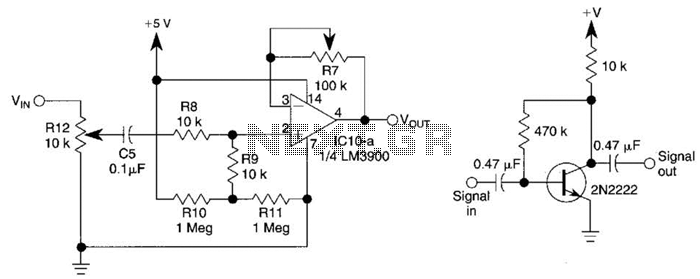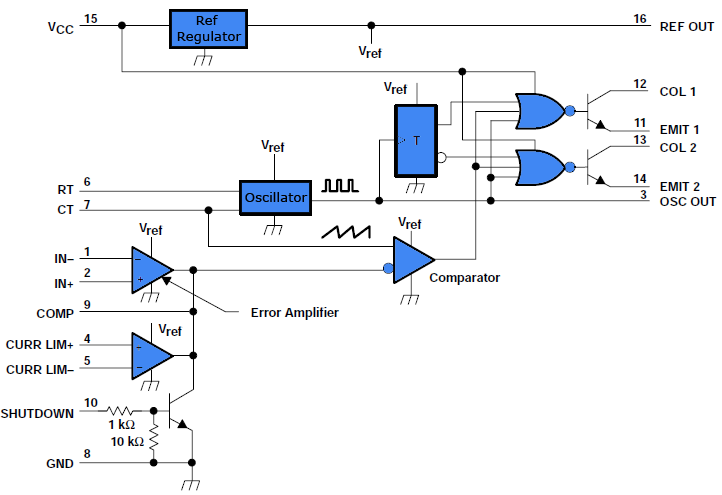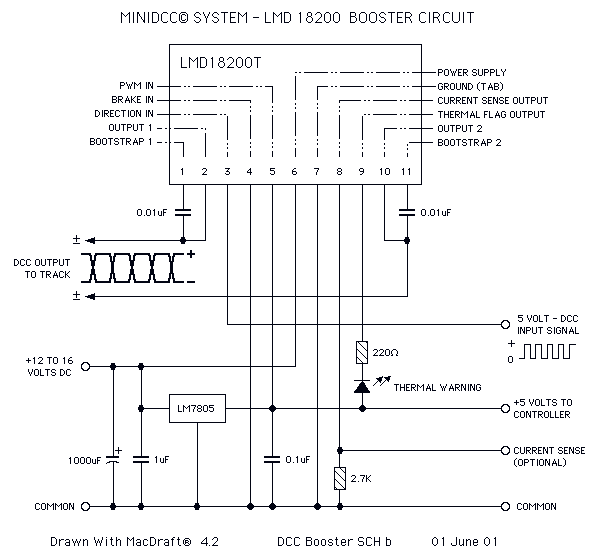
Variable Gain Amplifier Circuit

This circuit utilizes one-quarter of an LM3900 to create a simple variable-gain front end for an oscilloscope. R7 serves as the gain control. Additionally, a basic preamplifier is included for applications requiring more than 10X gain.
The circuit employs the LM3900, a quad operational amplifier, configured in a non-inverting amplifier setup to achieve variable gain. The gain control resistor, R7, is strategically placed in the feedback loop of the op-amp to allow for adjustment of the gain from unity up to a specified maximum, which can exceed 10X. This feature is particularly beneficial for oscilloscope applications where signal amplification is necessary to visualize low-level signals effectively.
In the schematic, the input signal is fed into the non-inverting terminal of the op-amp. The gain can be adjusted by changing the value of R7; as R7 decreases, the gain increases, allowing for a flexible response to varying input signal levels. The output of the op-amp is then connected to the oscilloscope input, enabling the user to observe the amplified signal.
The preamplifier section, which is also part of the circuit, enhances the input signal before it reaches the variable gain stage. This preamplifier can be implemented using another section of the LM3900, ensuring that even very weak signals can be adequately amplified to a level suitable for further processing. The design considerations for the preamplifier include low noise and high input impedance to avoid loading the signal source.
Overall, this circuit design is efficient for applications requiring adjustable gain and is particularly suited for use in laboratory settings or in equipment where signal integrity and flexibility are paramount. This circuit uses 1/4 of an LM3900 to build a simple variable-gain front end for an oscilloscope. R7 is the gain control. Also shown is a simple preamp if you need more than 10X of gain.
The circuit employs the LM3900, a quad operational amplifier, configured in a non-inverting amplifier setup to achieve variable gain. The gain control resistor, R7, is strategically placed in the feedback loop of the op-amp to allow for adjustment of the gain from unity up to a specified maximum, which can exceed 10X. This feature is particularly beneficial for oscilloscope applications where signal amplification is necessary to visualize low-level signals effectively.
In the schematic, the input signal is fed into the non-inverting terminal of the op-amp. The gain can be adjusted by changing the value of R7; as R7 decreases, the gain increases, allowing for a flexible response to varying input signal levels. The output of the op-amp is then connected to the oscilloscope input, enabling the user to observe the amplified signal.
The preamplifier section, which is also part of the circuit, enhances the input signal before it reaches the variable gain stage. This preamplifier can be implemented using another section of the LM3900, ensuring that even very weak signals can be adequately amplified to a level suitable for further processing. The design considerations for the preamplifier include low noise and high input impedance to avoid loading the signal source.
Overall, this circuit design is efficient for applications requiring adjustable gain and is particularly suited for use in laboratory settings or in equipment where signal integrity and flexibility are paramount. This circuit uses 1/4 of an LM3900 to build a simple variable-gain front end for an oscilloscope. R7 is the gain control. Also shown is a simple preamp if you need more than 10X of gain.





